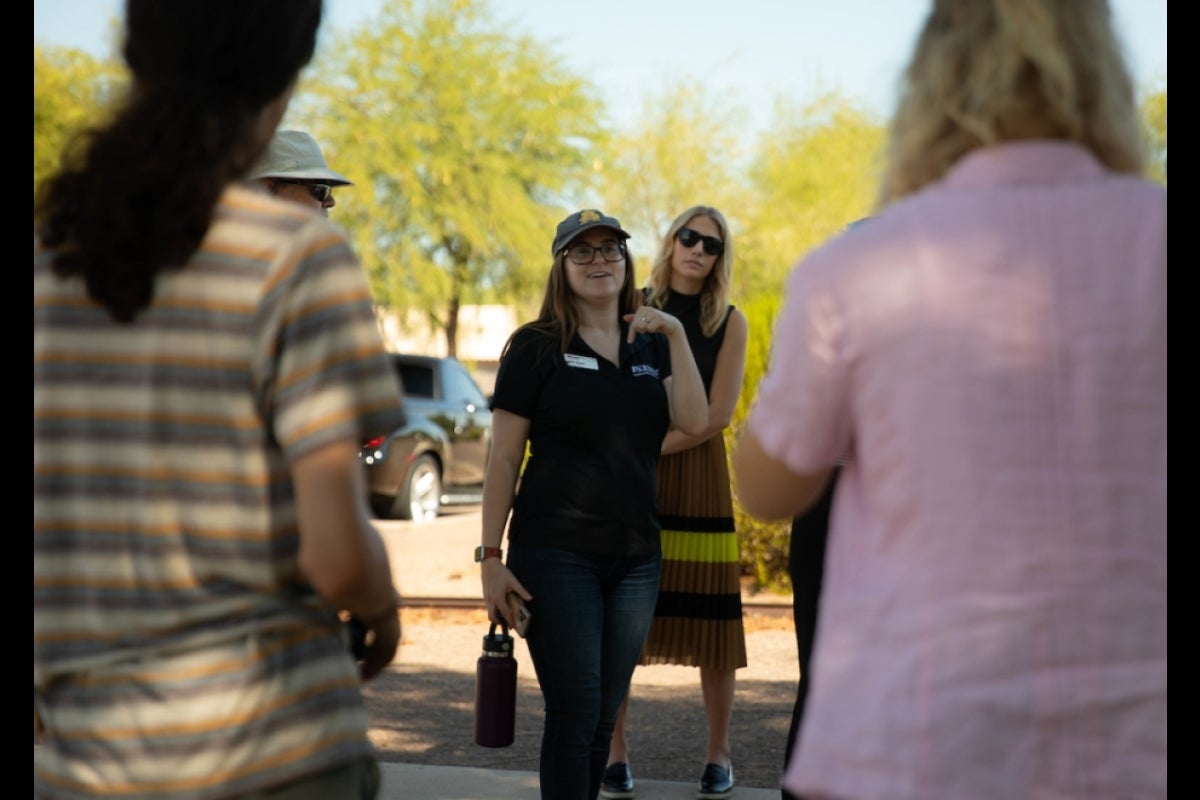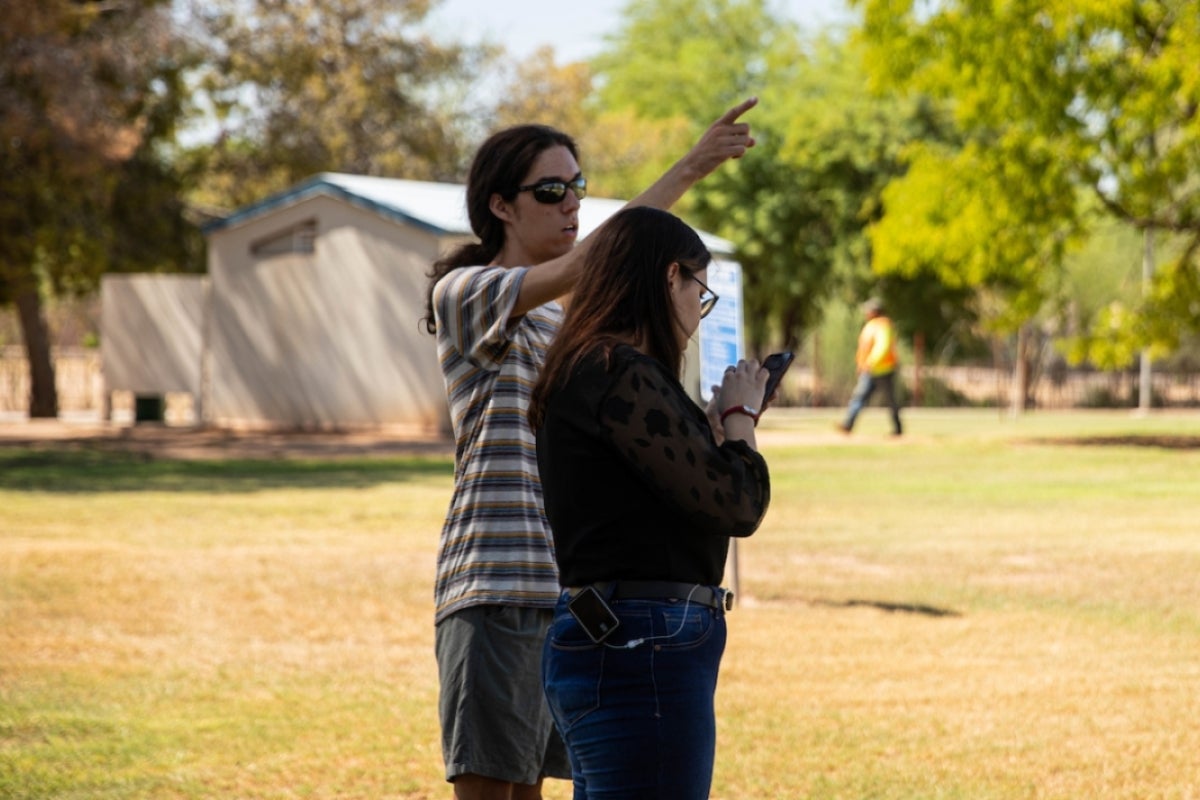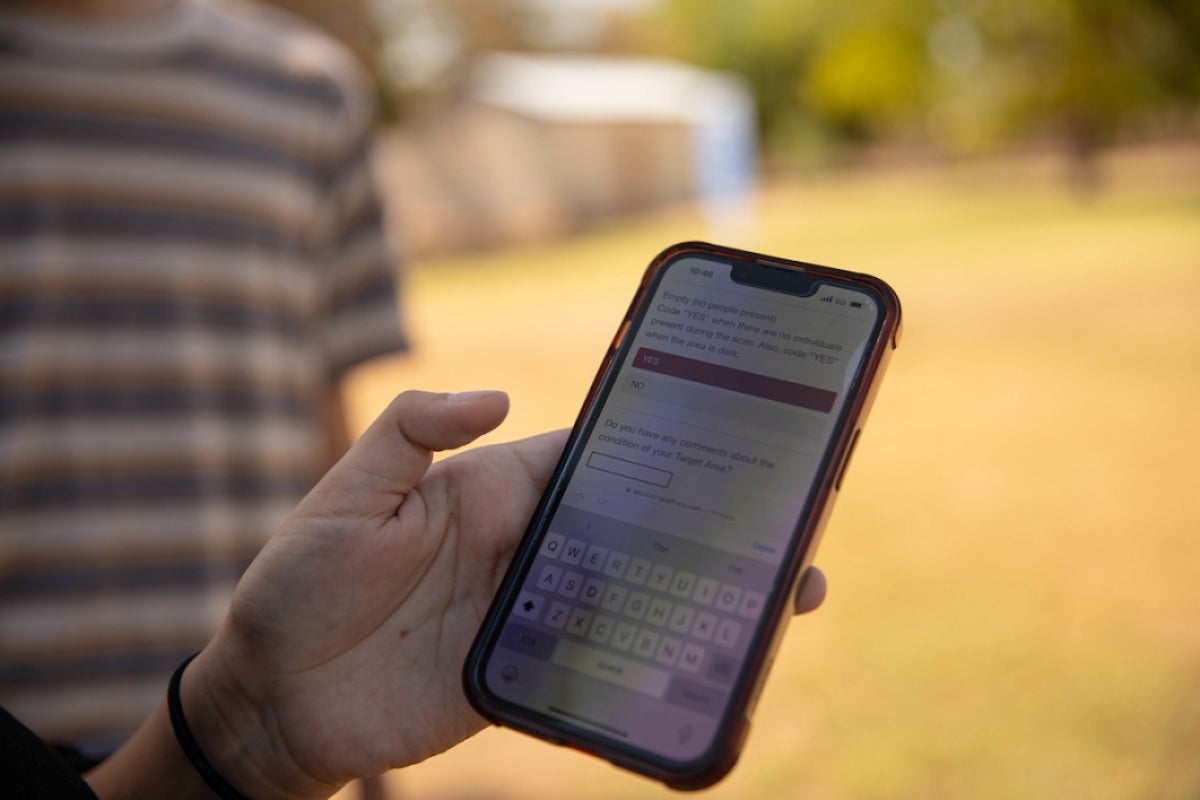A day in the park

ASU students, faculty and city of Chandler staff gather for a debrief after conducting their fieldwork and discuss the future of their new Project Cities partnership at Desert Breeze Community Park in Chandler on Sept. 7. Photo by Paula Soria/ASU News
Before Frederick Law Olmsted and Calvert Vaux envisioned Central Park as the bucolic New York City landmark it is today, the land there was swampy and full of rocks.
The acreage in San Francisco’s Golden Gate Park was seen as a “dreary desert” before William Hammond Hall transformed it into an oasis.
Boston Common was used as a military camp for British soldiers before George Meacham put his touch on the 50-acre park, which included a garden with a pond, a curved path system, and flowerbeds.
Now we can add a group of Arizona State University students to this list of innovative minds who have made memorable contributions to the urban park system.
“Students often come up with ‘blue sky’ thinking in that they’re not burdened by tradition,” said Christopher Boone, a professor in ASU’s School of Sustainability. “They bring in a fresh perspective and a bolt of energy, enthusiasm and fresh ideas that hopefully can be turned into recommendations.”
Boone is referring to a new collaboration with the city of Chandler called Project Cities, where ASU students — through his Professional Skills in Sustainability Practice course — provide local communities with thoughtful, sustainable solutions for better environmental, economic and social balances and outcomes.
The program is offered through the Sustainable Cities Network in ASU's Global Institute of Sustainability and Innovation. Project Cities is a university-community alliance that connects ASU students and faculty with projects and sustainability needs faced by local community partners while providing students opportunities to gain real-world experience and develop potential career pathways.
It’s a win-win for everyone involved, said Julia Davis, project manager for Project Cities.
“Project Cities provides a unique opportunity for communities to bring multiple sustainability challenges to the table, even from across different city departments,” Davis said. “During a semester, students from one class can tackle a project focused on communication strategies or historic preservation, while students from another course may be focusing on transportation or infrastructure improvements. At the end of the semester, the city leaves with a myriad of solutions that benefit the whole community.”
Davis said since the program started in 2017, Project Cities has facilitated 98 projects with eight community partners throughout Arizona. She added that Project Cities is currently working with the city of Phoenix on residential xeriscape design research; the town of Gilbert on several solid-waste projects; and the town of Miami to develop a strategic framework for a general plan.
Last month, the Chandler City Council entered a five-year agreement with ASU’s School of Sustainability. Their first challenge will be to review five of Chandler’s city parks to see how they’re being utilized and suggest ways to improve their sustainability efforts.
Boone and his students met with staffers at Chandler City Hall on Sept. 7 to discuss the new partnership, the core mission and what they can do to improve the parks earmarked for improvements.
“We’re so excited to have this partnership with ASU because you’ve got so many great ideas,” said John Sefton, Chandler’s community services director, who oversees the city’s libraries, parks and recreation facilities. “More and more people are using our parks, and we want your help in giving them the best possible experience.”
With Sefton leading the way, 19 students visited Chandler’s Desert Breeze Park to find ways to increase usage and suggest sustainable enhancements to the park.
Students were broken down into five groups based on different park “zones” to record park accessibility and usability, as well as study park user activities. And because sustainability students are action-oriented, it didn’t take long for park improvement ideas to start percolating.
Madeline Topel was assigned to record observations of the park’s human-made lake, which she noticed was green and murky. She suggested the city investigate using plant life, bacteria and other biological materials to create a self-contained pool that filters water and fights algae.
“This system would not only look nicer, but it would be more cost effective for the city in that they wouldn’t have to pay for chlorine or dye,” said Topel, a third-year sustainability student. “It’s also good for the environment, and it probably would not absorb as much heat.”
Thalia Longo took notice of the park’s splash pad, which used continual running water. She thought it was a waste.
“Ever since I’ve been here, that water has been running,” said Longo, a second-year sustainability major. “I need to ask if it’s being recycled, but if not, they could install a button that allows the water to run for five to 10 minutes, but then automatically shuts off. Otherwise, it’s a waste of water.”
Joyce Priebe was asked to analyze how many people were utilizing Desert Breeze’s baseball field. She took a swing and connected.
“The field itself could be multiuse, and for different cultural groups,” said Priebe, a third-year sustainability major. “It’s only set up for baseball, and could be adapted for cricket or a bocce court. Something that might cater to others.”
Second-year sustainability student Nathan Morgan saw a need for more bike racks and shade in certain parts of the park.
“The general-use field was quite open to the sun, and it could be covered,” Morgan said. “More bike racks would attract a younger clientele to the park.”
Over the next five weeks, Boone’s students will continue their fieldwork with visits to Tumbleweed Regional Park, Pima Community Park, Brooks Crossing Neighborhood Park and Citrus Vista Neighborhood Park.
If the partnership goes well, the city is considering collaborating with students to help with sustainability planning, community placemaking and a variety of other projects based on community need, according to Davis.
Sefton certainly believes it will. He was impressed with the plethora of ideas that came from just a few hours of observation. He made a vow to the group before they headed back to ASU’s Tempe campus:
“Know that the work you do will get used.”
More Environment and sustainability

Mapping the way to harvesting water from air
Earth’s atmosphere contains about 13 trillion tons of water.That’s a lot of water to draw upon to help people who are contending with drought, overtaxed rivers and shrinking aquifers.In fact,…

ASU researchers test environmental risks of tire emissions on Arizona highways
The Greater Phoenix area’s roadway grid system is the envy of urban planners everywhere, and the Arizona Department of Transportation, or ADOT, strives for nothing less than…

A 6-month road repair that only takes 10 days, at a fraction of the cost? It's reality, thanks to ASU concrete research
While Arizona’s infrastructure may be younger than its East Coast counterparts, the effects of aging in a desert climate have begun to take a toll on its roads, bridges and railways. Repairs and…







